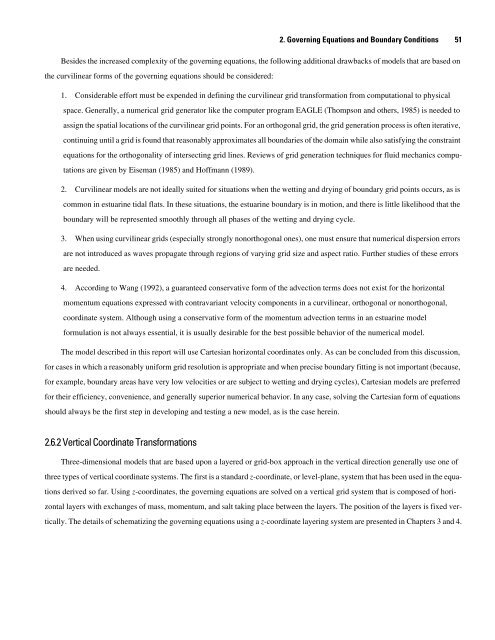A Semi-Implicit, Three-Dimensional Model for Estuarine ... - USGS
A Semi-Implicit, Three-Dimensional Model for Estuarine ... - USGS
A Semi-Implicit, Three-Dimensional Model for Estuarine ... - USGS
Create successful ePaper yourself
Turn your PDF publications into a flip-book with our unique Google optimized e-Paper software.
2. Governing Equations and Boundary Conditions 51<br />
Besides the increased complexity of the governing equations, the following additional drawbacks of models that are based on<br />
the curvilinear <strong>for</strong>ms of the governing equations should be considered:<br />
1. Considerable ef<strong>for</strong>t must be expended in defining the curvilinear grid trans<strong>for</strong>mation from computational to physical<br />
space. Generally, a numerical grid generator like the computer program EAGLE (Thompson and others, 1985) is needed to<br />
assign the spatial locations of the curvilinear grid points. For an orthogonal grid, the grid generation process is often iterative,<br />
continuing until a grid is found that reasonably approximates all boundaries of the domain while also satisfying the constraint<br />
equations <strong>for</strong> the orthogonality of intersecting grid lines. Reviews of grid generation techniques <strong>for</strong> fluid mechanics compu-<br />
tations are given by Eiseman (1985) and Hoffmann (1989).<br />
2. Curvilinear models are not ideally suited <strong>for</strong> situations when the wetting and drying of boundary grid points occurs, as is<br />
common in estuarine tidal flats. In these situations, the estuarine boundary is in motion, and there is little likelihood that the<br />
boundary will be represented smoothly through all phases of the wetting and drying cycle.<br />
3. When using curvilinear grids (especially strongly nonorthogonal ones), one must ensure that numerical dispersion errors<br />
are not introduced as waves propagate through regions of varying grid size and aspect ratio. Further studies of these errors<br />
are needed.<br />
4. According to Wang (1992), a guaranteed conservative <strong>for</strong>m of the advection terms does not exist <strong>for</strong> the horizontal<br />
momentum equations expressed with contravariant velocity components in a curvilinear, orthogonal or nonorthogonal,<br />
coordinate system. Although using a conservative <strong>for</strong>m of the momentum advection terms in an estuarine model<br />
<strong>for</strong>mulation is not always essential, it is usually desirable <strong>for</strong> the best possible behavior of the numerical model.<br />
The model described in this report will use Cartesian horizontal coordinates only. As can be concluded from this discussion,<br />
<strong>for</strong> cases in which a reasonably uni<strong>for</strong>m grid resolution is appropriate and when precise boundary fitting is not important (because,<br />
<strong>for</strong> example, boundary areas have very low velocities or are subject to wetting and drying cycles), Cartesian models are preferred<br />
<strong>for</strong> their efficiency, convenience, and generally superior numerical behavior. In any case, solving the Cartesian <strong>for</strong>m of equations<br />
should always be the first step in developing and testing a new model, as is the case herein.<br />
2.6.2 Vertical Coordinate Trans<strong>for</strong>mations<br />
<strong>Three</strong>-dimensional models that are based upon a layered or grid-box approach in the vertical direction generally use one of<br />
three types of vertical coordinate systems. The first is a standard z-coordinate, or level-plane, system that has been used in the equa-<br />
tions derived so far. Using z-coordinates, the governing equations are solved on a vertical grid system that is composed of hori-<br />
zontal layers with exchanges of mass, momentum, and salt taking place between the layers. The position of the layers is fixed ver-<br />
tically. The details of schematizing the governing equations using a z-coordinate layering system are presented in Chapters 3 and 4.

















